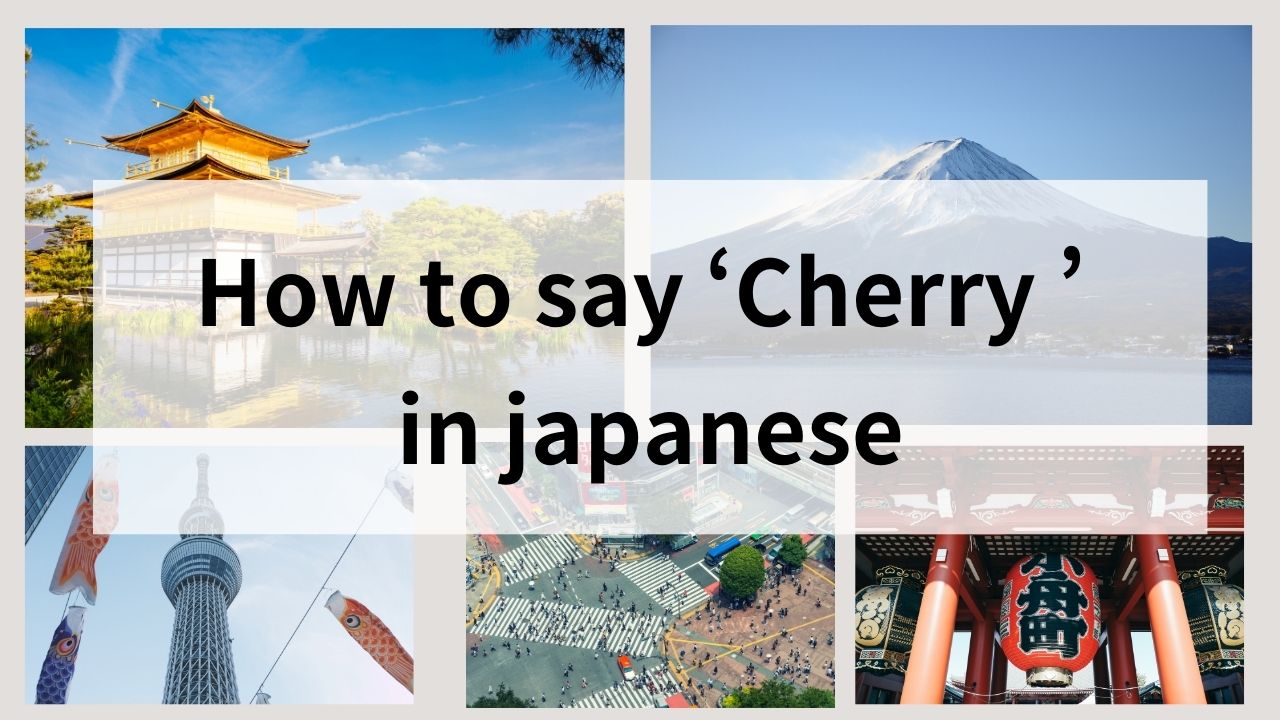- Attack on Titan: The character Eren Yeager is often seen beneath cherry blossom trees, symbolizing hope and the fleeting nature of freedom.
- Your Name (Kimi no Na wa): Cherry blossoms are a central motif in this film, representing love and connection.
- Pokemon: Various Pokémon, such as Cherrim, are directly inspired by cherry blossoms, emphasizing their beauty and the joy of spring.
- My Neighbor Totoro: The film features cherry blossoms as a backdrop to the beauty of nature and childhood innocence.
- Final Fantasy: The cherry blossom tree is often depicted in various games, symbolizing beauty and the passage of time.
These examples illustrate how cherry blossoms continue to embody beauty, hope, and the cycle of life in both traditional and contemporary narratives.
Differences Between Cherry in Japan and Overseas
There can be subtle differences in how “cherry” is perceived in Japan versus Western cultures. In Japan, “sakura” (桜) specifically refers to the blossoms and carries deep cultural significance, while “cherry” in the West may more commonly refer to the fruit. Understanding these cultural nuances can help avoid confusion, especially in discussions about nature and symbolism.
Practical Applications of “Cherry” in Japanese
Learning how “cherry” is used in Japanese can enhance conversations, understanding of idioms, and recognition of its cultural presence.
Talking About Cherry in Daily Conversation
Here are some examples of how “sakura” is used in everyday conversation:
- 桜が好きです (Sakura ga suki desu): “I like cherry blossoms.”
- 桜の季節です (Sakura no kisetsu desu): “It’s cherry blossom season.”
Cherry-Related Idioms or Expressions
While there are relatively few specific idioms involving “sakura,” the cherry blossom is often associated with beauty, renewal, and the passage of time in Japanese culture. Here are some idioms and expressions that incorporate or symbolize cherry blossoms:
- 桜舞う (Sakura mau): “Cherry blossoms dance,” a phrase used to describe the beauty of petals falling.
- 桜吹雪 (Sakurafubuki): “Cherry blossom snow,” referring to a picturesque scene of falling cherry petals.
- 桜の下で (Sakura no shita de): “Under the cherry blossoms,” often used to refer to gatherings or celebrations held during hanami.
- 桜の花言葉 (Sakura no hanakotoba): “The language of cherry blossoms,” referring to the meanings attributed to different flowers.
- 桜の木の下 (Sakura no ki no shita): “Under the cherry blossom tree,” symbolizing a moment of peace and beauty.
These idioms and expressions reflect the cultural and aesthetic appreciation of cherry blossoms in Japan, often tied to themes of beauty, renewal, and the transient nature of life. By learning these phrases, you can gain a deeper understanding of how sakura is interwoven with Japanese language and values.
Cherry in Japanese Cuisine or Products
Cherry blossoms and cherries also feature prominently in Japanese cuisine, showcasing their aesthetic appeal and unique flavors. Here are some notable examples:
- Cherry Blossom Flavored Sweets: Many traditional Japanese sweets, like sakura mochi and sakura daifuku, incorporate the flavor of cherry blossoms, celebrating their delicate taste.
- Cherry Fruit (さくらんぼ, Sakuranbo): The fruit is enjoyed fresh, in desserts, or as a topping for various dishes, often appreciated for its sweetness and vibrant color.
- Sakura Tea: This tea, made from dried cherry blossoms, is enjoyed for its fragrant aroma and subtle flavor, often served during special occasions.
These examples highlight how cherries and cherry blossoms are not only visually appealing but also culturally significant in Japanese cuisine, adding richness and depth to both traditional and modern dishes.
FAQs
Here are some frequently asked questions about cherry in Japanese culture and language.
Is Cherry a Popular Symbol in Japan?
Yes, cherry blossoms are a highly popular symbol in Japan, often associated with beauty, renewal, and the transient nature of life. They play a significant role in cultural celebrations and festivals.
How Do You Write “Cherry” in Japanese?
The word “cherry” can be written in three different scripts in Japanese: hiragana, katakana, and kanji. Each script serves different purposes depending on the context and formality. Here’s a breakdown:
- Hiragana (さくらんぼ, Sakuranbo):
Hiragana is commonly used for the cherry fruit in casual writing, making it easy to read and suitable for everyday use. - Katakana (サクランボ, Sakuranbo):
Katakana can be used for emphasis or in stylistic contexts, such as advertisements or product names. - Kanji (桜, Sakura):
Kanji represents cherry blossoms and is often used in literature, cultural contexts, and artistic expressions, conveying a sense of elegance.
Choosing which script to use depends on the tone, audience, and purpose of your communication. Understanding these variations can enhance both your written and spoken Japanese skills.
Conclusion
Cherry, or “sakura” in Japanese, is more than just a flower—it symbolizes beauty, renewal, and the transient nature of life. By understanding its role in Japanese language and traditions, you can deepen your appreciation for this iconic symbol and its significance in Japanese society.
Are you curious about how to say “cherry” in Japanese? The cherry tree, especially the famous sakura (桜), holds immense cultural significance in Japan, symbolizing the beauty and transience of life. This guide will explore the Japanese word for “cherry,” its cultural importance, and how it is used in various contexts.
How Do You Say “Cherry” in Japanese?
The Japanese word for “cherry” is 桜 (sakura). This term is primarily used to refer to cherry blossoms, which are celebrated throughout Japan during the spring season. The beauty of sakura and its fleeting nature is a recurring theme in Japanese art and literature.
The Japanese Word for Cherry: Sakura (桜)
“Sakura” refers specifically to cherry blossoms, while the word for cherry fruit is さくらんぼ (sakuranbo). Here are some examples of how “sakura” is used in various phrases:
- 桜の花 (Sakura no hana): “Cherry blossom flower.”
- 桜の木 (Sakura no ki): “Cherry blossom tree.”
- 桜の季節 (Sakura no kisetsu): “Cherry blossom season.”
Kanji for Cherry: 桜
The kanji for cherry blossom, 桜, is widely used in both literature and everyday language. This character represents the beauty and ephemeral nature of the blossoms, making it a significant symbol in Japanese culture. The primary reading for this kanji is さくら (Sakura).
Examples of words containing the kanji 桜 include:
- 桜前線 (Sakurazensen): “Cherry blossom front,” the phenomenon of cherry blossoms blooming from south to north in Japan.
- 桜餅 (Sakuramochi): “Cherry blossom rice cake,” a traditional sweet treat wrapped in leaves of cherry blossoms.
- 桜吹雪 (Sakurafubuki): “Cherry blossom snow,” referring to the sight of cherry petals falling like snow.
This kanji’s association with beauty and the fleeting nature of life is particularly poignant in Japanese culture, reflecting a deep appreciation for nature and its cycles.
Does “Cherry” Work in Japanese?
The English word “cherry” is generally understood in Japan, especially among those familiar with Western culture or cuisine. However, the specific meanings might not align perfectly with the cultural significance of “sakura.” A 5-point scale rates its comprehension as:
- Rating: 4 – Generally understood (60-80% of people)
For clearer communication, using the Japanese term 桜 (sakura) for cherry blossoms or さくらんぼ (sakuranbo) for the fruit itself is recommended. This ensures that your message resonates with the cultural context.
The Cultural Significance of Cherry in Japan
Cherry blossoms have held a special place in Japanese culture for centuries, symbolizing beauty, renewal, and the transience of life. The tradition of hanami, or cherry blossom viewing, is a cherished practice during spring when people gather to appreciate the fleeting beauty of the blossoms.
Cherry Blossoms as a Symbol of Beauty
Sakura symbolizes the fleeting nature of life, as the blossoms bloom vibrantly for only a short period. This has led to their association with the philosophy of mono no aware, which emphasizes the beauty of impermanence.
Cherry Blossoms in Japanese Folklore and Mythology
Cherry blossoms appear in various myths and stories, often associated with gods and spirits. They symbolize renewal and the arrival of spring, marking the end of the cold winter months.
In addition to their traditional significance, cherry blossoms play a vital role in modern Japanese pop culture, featuring prominently in anime, games, and festivals. This connection highlights the enduring appeal of sakura and its deep-rooted symbolism.
- Attack on Titan: The character Eren Yeager is often seen beneath cherry blossom trees, symbolizing hope and the fleeting nature of freedom.
- Your Name (Kimi no Na wa): Cherry blossoms are a central motif in this film, representing love and connection.
- Pokemon: Various Pokémon, such as Cherrim, are directly inspired by cherry blossoms, emphasizing their beauty and the joy of spring.
- My Neighbor Totoro: The film features cherry blossoms as a backdrop to the beauty of nature and childhood innocence.
- Final Fantasy: The cherry blossom tree is often depicted in various games, symbolizing beauty and the passage of time.
These examples illustrate how cherry blossoms continue to embody beauty, hope, and the cycle of life in both traditional and contemporary narratives.
Differences Between Cherry in Japan and Overseas
There can be subtle differences in how “cherry” is perceived in Japan versus Western cultures. In Japan, “sakura” (桜) specifically refers to the blossoms and carries deep cultural significance, while “cherry” in the West may more commonly refer to the fruit. Understanding these cultural nuances can help avoid confusion, especially in discussions about nature and symbolism.
Practical Applications of “Cherry” in Japanese
Learning how “cherry” is used in Japanese can enhance conversations, understanding of idioms, and recognition of its cultural presence.
Talking About Cherry in Daily Conversation
Here are some examples of how “sakura” is used in everyday conversation:
- 桜が好きです (Sakura ga suki desu): “I like cherry blossoms.”
- 桜の季節です (Sakura no kisetsu desu): “It’s cherry blossom season.”
Cherry-Related Idioms or Expressions
While there are relatively few specific idioms involving “sakura,” the cherry blossom is often associated with beauty, renewal, and the passage of time in Japanese culture. Here are some idioms and expressions that incorporate or symbolize cherry blossoms:
- 桜舞う (Sakura mau): “Cherry blossoms dance,” a phrase used to describe the beauty of petals falling.
- 桜吹雪 (Sakurafubuki): “Cherry blossom snow,” referring to a picturesque scene of falling cherry petals.
- 桜の下で (Sakura no shita de): “Under the cherry blossoms,” often used to refer to gatherings or celebrations held during hanami.
- 桜の花言葉 (Sakura no hanakotoba): “The language of cherry blossoms,” referring to the meanings attributed to different flowers.
- 桜の木の下 (Sakura no ki no shita): “Under the cherry blossom tree,” symbolizing a moment of peace and beauty.
These idioms and expressions reflect the cultural and aesthetic appreciation of cherry blossoms in Japan, often tied to themes of beauty, renewal, and the transient nature of life. By learning these phrases, you can gain a deeper understanding of how sakura is interwoven with Japanese language and values.
Cherry in Japanese Cuisine or Products
Cherry blossoms and cherries also feature prominently in Japanese cuisine, showcasing their aesthetic appeal and unique flavors. Here are some notable examples:
- Cherry Blossom Flavored Sweets: Many traditional Japanese sweets, like sakura mochi and sakura daifuku, incorporate the flavor of cherry blossoms, celebrating their delicate taste.
- Cherry Fruit (さくらんぼ, Sakuranbo): The fruit is enjoyed fresh, in desserts, or as a topping for various dishes, often appreciated for its sweetness and vibrant color.
- Sakura Tea: This tea, made from dried cherry blossoms, is enjoyed for its fragrant aroma and subtle flavor, often served during special occasions.
These examples highlight how cherries and cherry blossoms are not only visually appealing but also culturally significant in Japanese cuisine, adding richness and depth to both traditional and modern dishes.
FAQs
Here are some frequently asked questions about cherry in Japanese culture and language.
Is Cherry a Popular Symbol in Japan?
Yes, cherry blossoms are a highly popular symbol in Japan, often associated with beauty, renewal, and the transient nature of life. They play a significant role in cultural celebrations and festivals.
How Do You Write “Cherry” in Japanese?
The word “cherry” can be written in three different scripts in Japanese: hiragana, katakana, and kanji. Each script serves different purposes depending on the context and formality. Here’s a breakdown:
- Hiragana (さくらんぼ, Sakuranbo):
Hiragana is commonly used for the cherry fruit in casual writing, making it easy to read and suitable for everyday use. - Katakana (サクランボ, Sakuranbo):
Katakana can be used for emphasis or in stylistic contexts, such as advertisements or product names. - Kanji (桜, Sakura):
Kanji represents cherry blossoms and is often used in literature, cultural contexts, and artistic expressions, conveying a sense of elegance.
Choosing which script to use depends on the tone, audience, and purpose of your communication. Understanding these variations can enhance both your written and spoken Japanese skills.
Conclusion
Cherry, or “sakura” in Japanese, is more than just a flower—it symbolizes beauty, renewal, and the transient nature of life. By understanding its role in Japanese language and traditions, you can deepen your appreciation for this iconic symbol and its significance in Japanese society.








